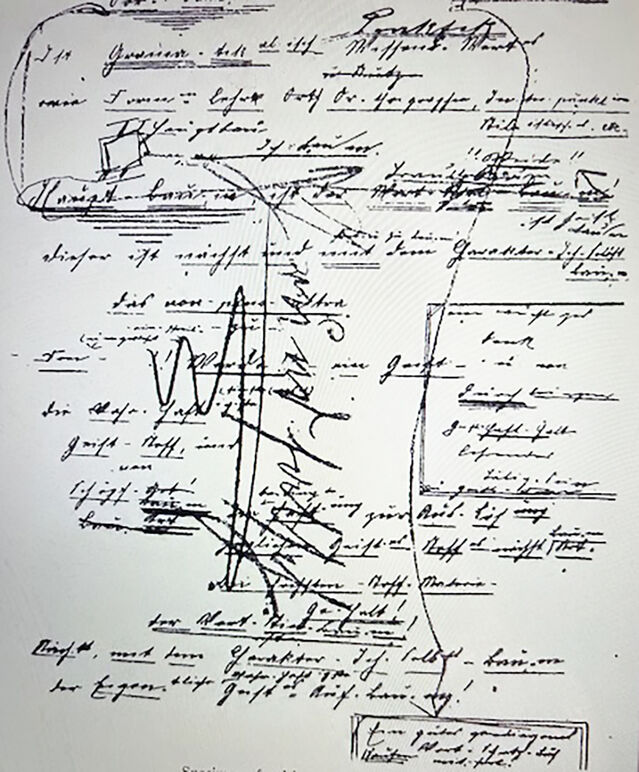Intelligence
Schizophrenia and Writing
How to distinguish great writing from schizography.
Posted February 28, 2022 Reviewed by Michelle Quirk
Key points
- The content of schizophrenic handwriting may suggest the diagnosis, and there may also be suggestive graphological clues.
- In contrast to bipolar psychosis, which occurs not uncommonly in poets and novelists, no literary giants are known to have had schizophrenia.
- James Joyce may have had a synaesthesia that provided him with an insight into schizophrenic language
On September 27, 1896, a person calling himself "ALIENIST” wrote to the New York Times alleging that the young Democratic party presidential candidate, William Jennings Bryan was of "unsound mind." In the correspondent’s view, Bryan suffered from oratorial incontinence, which he compared to graphomania, a monosymptomatic nervous disorder characterised by a morbid compulsion to write:
The habit of excessive writing, of explaining, amplifying, and reiterating, of letter making and pamphleteering, forms a morbid symptom known as "graphomania." Some men may overload their natural tendency to write, but a certain class of lunatics use nearly all their mental activities in this occupation, to the endless annoyance of their friends, relatives and physicians.
The popular press at that time warned of the damaging effect of "diseased" writing on a nation’s culture, and Victorian children were discouraged from writing too much in case it warped their minds. For some time after graphomania had been de-medicalised and passed into the vernacular the related word graphorrhoea continued to be used by physicians to describe a pathological writing disorder characterised by prolixity and incoherence that was commonly observed in schizophrenics.
Although it has long been recognised that there may be a disparity between the degree of disordered thought expressed in spoken speech and that found in spontaneous writing modern research into the language of psychotic speech is now largely done on voice recordings that are laboriously transcribed and then analysed using computerised software and e-semiotics. One of these studies reported that more third-person plural pronouns ("they") and fewer first-person singular pronouns ("I") were used by people with schizophrenia when compared to those with depression.
Graphorrhoea
Emil Kraepelin (1856–1926) in his textbook Dementia Praecox and Paraphrenia wrote that schizophrenia can sometimes be identified by a sample of writing. Its particular signature included elaborate capitals, ornate flourishes on individual letters, an absence or superfluity of umlauts and tittles, narrow slanting letters, multiple strikethroughs, and inappropriate underlining. At times, the written page seemed too small for the disorganised text that not uncommonly filled every available blank space. Word salads (e.g., "wetness smooth dancing sheep"), neologisms (e.g., "tarnharn"), klang associations (e.g., "Here he comes with a cat catch, a bat hatch, and a rat match"), and invented word substitutions like "time vessel" for a clock were some of the aberrations that reflected the patient’s disordered thinking and language.
The two figures below from Kraepelin’s textbook show the slovenly appearance. frequent changes in size and form of the script, the unusual arrangement of notes and irregular grouping of words, disconnected sentence fragments, written verbigerations, colourings and word monstrosities.

Embellishment of senseless texts with phantasmagorical drawings rather than illustrations or endless variations of the same fundamental form, sometimes referred to as metamorphoses were also common:

Eugen Bleuler (1857–1939), who first coined the term schizophrenia, commented on the distorted grammatical construction of sentences, the incomprehensible word usage, and impersonal telegrammatic writing style. He also drew attention to the inclination of schizophrenics to use convoluted sentence structures and pretentious and bombastic phrases, such as, "The undersigned writer of these lines takes the liberty of sending you this by mail."
Neuroleptic (antipsychotic) drugs used to treat schizophrenia can transform the handwriting causing a progressive micrographia, which, in some patients, may be an early warning sign of iatrogenic Parkinson’s syndrome, requiring dosage reduction and the use of anticholinergic drugs.
"Schizophrenic Writers"
Every person has his or her own private idiolect, which is closely linked to their nationality, upbringing, and personality, and most authors have a literary fingerprint although it is much harder to recognise than that of an artist or composer.
In contrast to the long list of novelists and poets with declared bipolar disorder and hypergraphia, the loss of self, delusional ideation and emotional distancing in schizophrenia make it virtually impossible to accomplish accessible and meaningful creative writing. Nevertheless, first-person written accounts are available to read in the pages of the Schizophrenia Bulletin and in a few exceptional recovery narratives such as The Center Cannot Hold by Elyn R. Sacks.
The outstanding example of an author whose writing might suggest schizophrenia is James Joyce (1882–1941). Finnegan’s Wake begins as follows:
riverrun, past Eve and Adam’s, from swerve of shore to bend of bay, brings us by a commodius vicus of recirculation back to Howth Castle and Environs.
Sir Tristram, violer d’amores, fr’over the short sea, had passencore rearrived from North Armorica on this side the scraggy isthmus of Europe Minor to wielderfight his penisolate war: nor had topsawyer’s rocks by the stream Oconee exaggerated themselse to Laurens County’s gorgios while they went doublin their mumper all the time: nor avoice from afire bellowsed mishe mishe to tauftauf thuartpeatrick: not yet, though venissoon after, had a kidscad buttended a bland old isaac: not yet, though all's fair invanessy, were sosie sesthers wroth with twone nathandjoe. Rot a peck of pa's malt had Jhem or Shen brewed by arclight and rory end to the regginbrow was to be seen ringsome on the aquaface.
Thefall(bababadalgharaghtakamminarronnkonnbronntonnerronntuonnthunntrovarrhounawnskawntoohoohoordenenthur-nuk!) of a once wallstrait oldparr is retaled early in bed and later on life down through all christian minstrelsy. The great fall of the offwall entailed at such short notice the pftjschute of Finnegan, erse solid man, that the humptyhillhead of humself prumptly sends an unquiring one well to the west in quest of his tumptytumtoes: and their upturnpikepointandplace is at the knock out in the park where oranges have been laid to rust upon the green since devlinsfirst loved livvy.
The book considered Joyce's most difficult by literary critics is riddled with neologisms and puns and ends with the missing first part of the introductory sentence, so completing a circle.
Max Nordau (1849–1920), a Hungarian who founded the World Zionist Movement, wrote in his best-selling book Degeneration that many contemporary artists exhibited in their writing an atavistic disorder of the mind springing from a weakness of moral reasoning:
The crazed graphomaniac…cannot recognise in his book, as it lies finished before him, the satisfying expression of his thoughts, and he will always be tempted to begin his work afresh, a task which is endless, because it must consist in giving a fixed linguistic form to ideas which are formless.
Joyce was born too late to be classified by Nordau as yet another contagious degenerate, but following the publication of Ulysses one journalist described it as the work of a perverted lunatic with a particular literary interest in the latrine. Carl Jung who had treated Joyce’s daughter for schizophrenia provides a detailed review of Ulysses in Volume 15 of his Collected Works where he comments that the unsuspecting reader might understandably fling the book aside believing the author to be mad Jung noted Joyce's use of fragmentary quotations, sound and speech associations, inventionof portmanteau words, abrupt transitions and hiatuses of thought, and liberal use of puns, but also drew attention to the fact that the visceral prose was always flowing and devoid of the stereotyped perseverations seen in schizophrenia. Jung concluded that Ulysses provided no evidence of psychosis in its author
Ulysses is no more a pathological product than modern art as a whole. It is "cubistic" in the deepest sense because it resolves the picture of reality into an immensely complex painting whose dominant note is the melancholy of abstract objectivity. Cubism is not a disease but a tendency to represent reality in a certain way—-and that way may be grotesquely realistic or grotesquely abstract.
Joyce’s writing is an example of ambiguous and opaque writing that defies syntax. Clauses that read forward and backward, cut up and paste in writing, commas instead of full stops, opaque writing that defies syntax and the use of disparate images smoothed by harmonious rhythms are all established accepted postmodernist writing ploys. Schizophrenic writing, on the other hand, is never contrived and always unexpurgated. It is sometimes written to be read by others but never to be declaimed and unlike great literary works, is never a source of income.
References
Critchley M. The Neurology of Psychotic Speech. Br J Psychiatry. 1964;110:353–364.
McKenna, P. and Oh, T. Schizophrenic Speech: Making Sense of Bathroots and Ponds That Fall in Doorways. Cambridge University Press, 2005.




